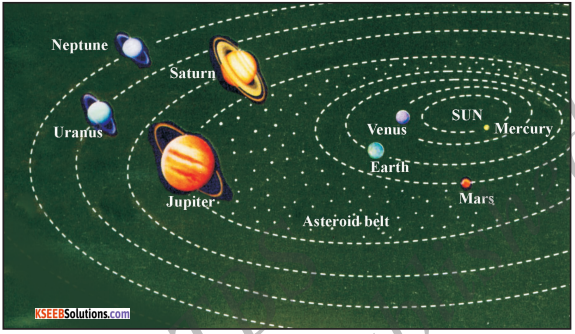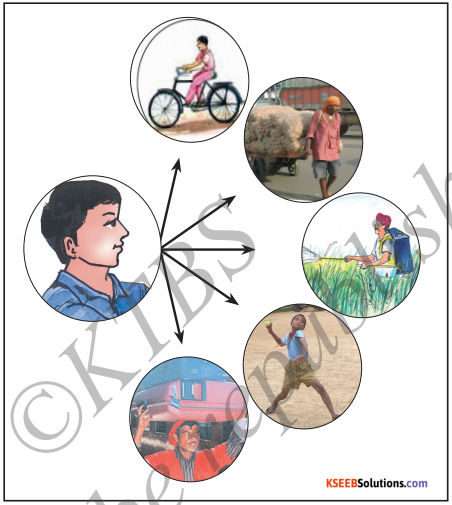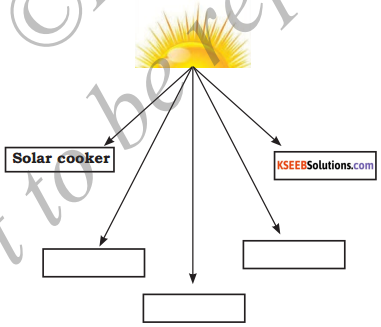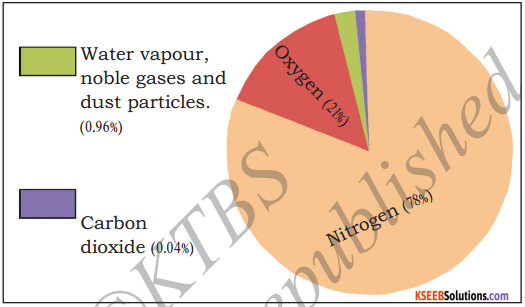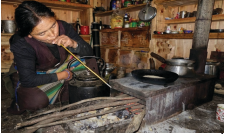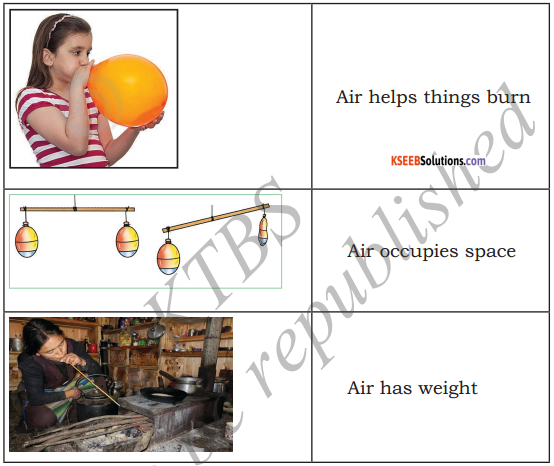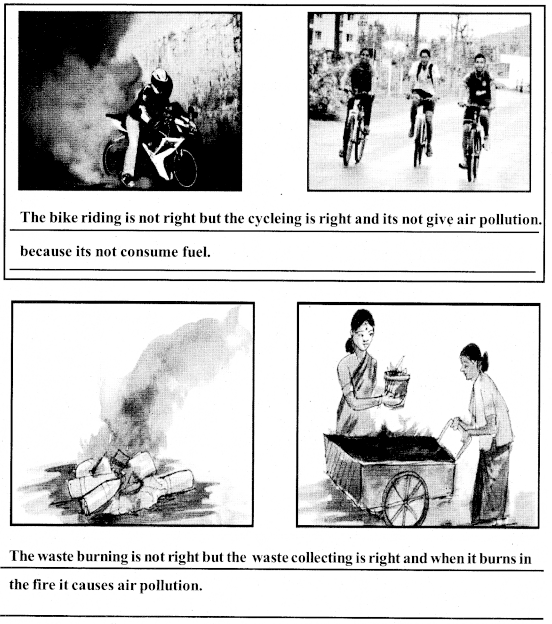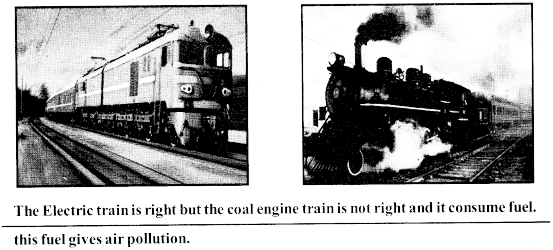Students can Download EVS Chapter 15 Our India – Physical Diversity Questions and Answers, Summary, Notes Pdf, KSEEB Solutions for Class 5 EVS helps you to revise the complete Karnataka State Board Syllabus and score more marks in your examinations.
Karnataka State Board Class 5 EVS Chapter 15 Our India – Physical Diversity
Class 5 EVS Our India – Physical Diversity Text Book Questions and Answers
Question 1.
What is landforms?
Answer:
The different types of land surfaces or known as landforms.
![]()
Question 2.
What is a mountain?
Answer:
Mountain is mighty and important landform. It is the uplifted portion of the earth’s surface and is much higher then the surrounding area.
Question 3.
What is a mountain range?
Answer:
A line of mountain is known mountain range.
Question 4.
What is a plateau?
Answer:
Plateaus are elevated flat lands with sleep sights. They are also called tablelands.
Question 5.
Which is the highest plateau in the world
Answer:
Plateau of Tibet.
Question 6.
What is a plain?
Answer:
The collection of various types of maps bound has a book is known as an atlas.
Question 7.
What is a desert?
Answer:
A scale is a ratio between the distance on the map and the corresponding distance on the ground.
Question 8.
Name any Island that belongs to India
Answer:
The Andaman, Nicobar and Laksha Dweep Islands belong to India.
![]()
Question 9.
What are natural regions?
Answer:
The basic components of a good map are title. Scale, Latitude direction and Index.
Question 10.
Which is the highest peak in the world
Answer:
Mt. Everest (8848 m).
Question 11.
Which is the highest peak in the Aravallis?
Answer:
Mt. Gurushikhar (1772m)
Question 12.
Which is the higest peak in South
Answer:
India (2695m)
Question 13.
What are called playas?
Answer:
Salt lakes are called plays.
Question 14.
Which is the largest salt lake in India?
Answer:
Sambhar lake.
Question 15.
Write a note about the peninsular plateau.
Answer:
- The peninsular plateau is to the south of the north Indian plains.
- The Narmada, Sone rift valley divides the plateau into two main plateaus.
- The northern pat is known as the Malwa plateau and the Southern part is known as Decan Plateau.
Question 16.
Find out the names of animals which live in the foothills of the Himalayas and make list of these animals.
Answer:
Leopards, Tiger, snow leopard, jungle cat, common langar
![]()
Question 17.
An unusually wide and long valley in the lower Himalayas is called Doons. For example: Dehradun in India. It is a popular tourist place. During summer people visit this place, why do they visit it
Answer:
Because Dehradun is in the Doon valley on the foothills ofthe Himalayas nestled between the river Ganges on the east and the river yarhuna on the west. The city is famous for its picturesque landscape and slightly milder climate and provides a gateway to the surrounding region.
Question 18.
The Northern plains are fertile, Give reasons:
Answer:
There are plains located to the south of Himalayan ranges. They are very vast, fertile and level. The Northern plains of India are formed by the deposition of alluvium camied by the rivers while flowing from the himalayan ranges.
Question 19.
The people prefer to live in the planis of rivers. Why?
Answer:
Because wherever there are river plains, there is plenty of water. Therefore agriculture, rearing of animals, transport facilities, trade and commerce and industries are developed.
Question 20.
Make a list of the important rivers and crops of our state.
Answer:
| Rivers | Crops |
| Krishna, Ghataprabha, Malaprabha, Tungbadra, Kaveri | Rice, Ragi, Jowar, Maize, cashews, Cardamom, Chillies, cotton, Sugar-cane & tobacco. |
Question 21.
Mention the names of the two important plateaus in India?
Answer:
Malwa plateau and Deccan plateau.
Question 22.
Mention the important historical places located in the peninsular plateau.
Answer:
Mysore, Badami, Hampi, Ooty, Hyderabad
Question 23.
Which Sea touches the coast of Karnataka?
Answer:
Arabian Sea
![]()
Question 24.
Which districts of Karnataka have coastal plain?
Answer:
Dakshina Kannada, Udupi and uttara Kannada.
Question 25.
Make the list of major crops grown in the western coastal plain of India?
Answer:
Betel nut, ragi, fodder, coconut, vegetables and rubber.
Question 26.
Make a study of the dress style and food habits of the fishermen living in coastal plains. Write 4 sentences on them
Answer:
Fishing is the main occupation of the people living in the coastal plain. So, most of the people eat fish. Agriculture is the another main occupation here.
Rice, are canuts, coconut, cashew, cardmam, banana and vegetables are grown here. The spinch, ivy gourd, black yed peas and samborr cucumber are also grown for food. The use of boiled rice is very popular.
Question 27.
What is an oasis?
Answer:
A fertile area in a desert is formed where the water comes up to the ground surface is called oasis.
Question 28.
Write about any 3 characteristics of the deserts?
Answer:
- A desert is a vast, dry and sandy area with very little vegetation
- The temperature is high and always climate is dry.
- Oasis occurs here.
Question 29.
Mention the names of any 3 protected forest areas in India?
Answer:
Sariska, Bandipur, Jim corbett, Gir forest
![]()
Question 30.
Discuss with your friends the Indian gered animals in India mention any 3 names of such animals.
Answer:
Tiger, asljatic lion, Asian Eleiphant
Question 31.
What are the problems arising from deforestation?
Answer:
Deforestation can have a negative impact on the environment the most dramatic impact is a loss of habitat for millions of species. Eighty percent of earth’s land animals and plants live in forests, and many cannot survive the deforestation that destroys their homes. Deforestation also drives Climate change.
Question 32.
Which animals are living around your environment make a list?
Answer:
Goat, Dog, Cat, Bullock, Rabbit etc.
Question 33.
What is cartography?
Answer:
The science and art of map-making is known as cartography.
Question 34.
Write any two old mountains?
Answer:
Aravalis and Appaltian
Question 35.
The Tibet also known as?
Answer:
Roof of the world.
Question 36.
Whcih is the largest desert in the world
Answer:
Sahara.
Question 37.
Name the types of the landforms?
Answer:
There are three major types of landforms. They are
- mountains
- Plateaus
- Plains
![]()
Question 38.
Name the types of mountains.
Answer:
Mountains are divided into three types fold .mountains, blow mountains and volcanic mountains.
Question 39.
What are called fold mountains? Give an example.
Answer:
Folding of rock layers of mountains are called fold mountains. They are highest mountains. The Himalayas andAlps are fold mountains.
Question 40.
Write any three or 4 importance of mountains.
Answer:
- Form natural boundaries between countries.
- Storehouse of resources.
- Sources of rivers
- Ideal for plantation crops.
Question 41.
Write the importance of plateaus.
Answer:
Plateaus are of great importance they are:
- storehouse of minerals.
- Very suitable.
- Fertile soid which is suitable for agriculture.
- Useful for animal rearing.
Question 42.
What is the position of India with regard to world population and land area?
Answer:
India is a peninsula south Asia. Inarealndia is the seventh-largest country and second most populous in the world.
Question 43.
What is the geogrphical location of India India?
Answer:
India extends from Kashmir in the north to kanyakumari in the south and from the Rann ofKutchchh in the west to Arunachal Pradesh in the east.
Question 44.
What is the position of Karnataka with regard to India’s land area?
Answer:
Karnataka is located in the southwestern part of India. It si the eighth largest state in India.
![]()
Question 45.
List the neighboring countries of India?
Answer:
The neighboring countries of India are Pakisthan, Afganistan, China, Nepal, Bhutan, Bangladesh, Myanmar and Srilanka.
Question 46.
Name the physical divisions of India?
Answer:
The main physical divisions of India are:
- The northern mountains
- The nothem Plains
- The peninsular Plateaus
- The coastal plains.
Question 47.
Which are the physical divisions of Karnataka?
Answer:
- Coastal Plain
- The malnad region
- The maidan region
Question 48.
Name the districts lying in the coastal area of Karnataka.
Answer:
Uttara Kannada, Udupi, Dakshina Kannada. The Andaman, Nicobar, and Laksha deep islands belong to India.
Class 5 EVS Our India – Physical Diversity Additional Questions and Answers
I. Multiple choice questions:
Question 1.
India is the largest country in the world
a) Eighth
b) Ninth
c) Seventh
d) Sixth
Answer:
c) Seventh
![]()
Question 2.
Our national capital territroy is
a) Kolkatta
b) Delhi
c) Mumbai
d) Pune
Answer:
b) Delhi
Question 3.
Ooty a famous hill station is located at
a) Nandi Hills
b) Shivaganga hills
c) Nilgiri hills
d)Savandurga hills
Answer:
c) Nilgiri hills
II. Fill in the blanks:
- A peak is the highest point of a mountain
- Mountains are generally made of hard rocks.
- The Himalayas and the Alps are young mountain.
- The higher slopes of the high mountains are covered with snow.
- Volcanic mountains are formed due to the accumulation of volcanic material.
- Desert can be rocky or sandy
- Desert are found in every continent except Europe and Antarctica.
- Small Islands are known as islets.
- A group of Islands is known as archipelago.
- India is located entirely in the northern and eastern hemispheres.
- The northern plains are located between the Himalayas and Peninsular plateaus.
- The Peninsular plateau is rich in minerals.
![]()
